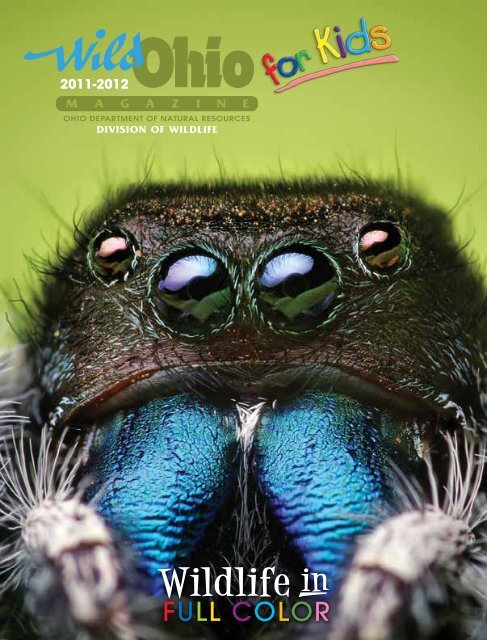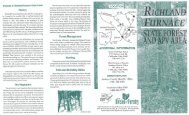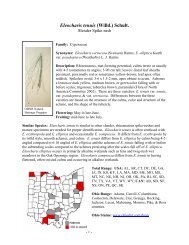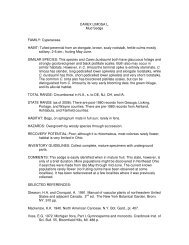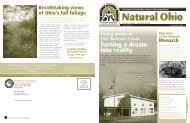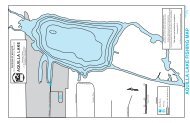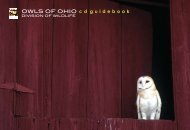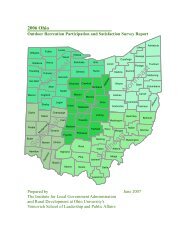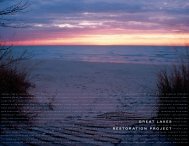Wildlife in Full Color - Ohio Department of Natural Resources
Wildlife in Full Color - Ohio Department of Natural Resources
Wildlife in Full Color - Ohio Department of Natural Resources
Create successful ePaper yourself
Turn your PDF publications into a flip-book with our unique Google optimized e-Paper software.
PRIMARYSurviv<strong>in</strong>g <strong>in</strong> a Wild WorldW I L D L I F E I N F U L L C O L O Rabitat is the place where an animallives – its home! Some <strong>of</strong> thehabitats found <strong>in</strong> our state are forests,grasslands, streams, lakes, and wetlands.Even your backyard and schoolyard canbe habitat for wildlife if you provide theth<strong>in</strong>gs that animals need.All animals need food, water, shelter,and space <strong>in</strong> their habitat to survive. Butsurvival doesn’t stop there! <strong>Wildlife</strong> havesome totally awesome traits, or “adaptations,”to help them meet the everydaychallenges <strong>of</strong> their wild world.Adaptations help wildlife move around<strong>in</strong> their habitat, f<strong>in</strong>d their next meal,escape from predators (other animalsthat might eat them), survive <strong>in</strong> w<strong>in</strong>ter,and f<strong>in</strong>d a mate. Adaptations <strong>in</strong>clude keensenses <strong>of</strong> eyesight, hear<strong>in</strong>g, touch, smell,sounds they make, and special behaviorsthey use. Many adaptations are physicalfeatures such as unique body parts.<strong>Color</strong> is an adaptation and an animal’scolor<strong>in</strong>g plays a huge role <strong>in</strong> help<strong>in</strong>g itsurvive – especially <strong>in</strong> hid<strong>in</strong>g from enemiesand attract<strong>in</strong>g a mate.ACTIVITY: ADAPTATION CONNECTIONDraw a l<strong>in</strong>e between the animal and its adaptation ( ) and the way that animal uses the adaptation ( O ). See answers on back coverUses its keen eyesight andhear<strong>in</strong>g to track its prey.Great Horned Owl1. Uses its specially adapted furto gracefully glide about.Southern Fly<strong>in</strong>g Squirrel2. Uses its long tongue to drawnectar from plants.Carol<strong>in</strong>a Sph<strong>in</strong>x Moth3. Buries itself undergroundto hibernate.Midland Pa<strong>in</strong>ted Turtle4. O Escape Enemies I O F<strong>in</strong>d Food I O Survive <strong>in</strong> W<strong>in</strong>ter I O Eat its Food I O Hide from Prey I O Protect Young I O Move About5. Hog-Nosed SnakePlays dead when threatenedor approached by a potentialpredator.6. Red-Banded Crab SpiderChanges its color to matchits surround<strong>in</strong>gs <strong>in</strong> order toattack prey.7. KilldeerDraws attention to itself <strong>in</strong>order to lure other animalsaway from the nest.RED-PURPLETER TIARYREDRED-ORANGEPRIMARYTER TIARYSECONDARYPURPLETER TIARYBLUE-PURPLE4WILD OHIO MAGAZINE 2011- 2012BLUE
The Thicket GameW I L D L I F E I N F U L L C O L O R<strong>in</strong>d some friends and play this version<strong>of</strong> the Project WILD activity “TheThicket Game.” (Teachers can f<strong>in</strong>d more<strong>in</strong>formation about Project WILD by visit<strong>in</strong>gohioprojectwild.com).ACTIVITY: HIDE AND FINDPick one person to be the “predator”and everyone else will be “prey.” Havethe predator close their eyes and countto 20 while all the prey hide. Everyonehid<strong>in</strong>g must be able to see some part <strong>of</strong>the predator at all times.ROUND 1:After the predator counts to 20, theyopen their eyes and beg<strong>in</strong> to look fortheir prey. The predator cannot movefrom where they started, but can lookaround, squat, or stand on their toes. Thepredator should call out the name <strong>of</strong> eachprey that can be seen and describe wherethey are. Each prey that is found movesto the predator’s location and waits untilthe next round to become a predator.When no more prey can be found, a newround starts.ROUND 2:All predators now close their eyes andcount to 20. Rema<strong>in</strong><strong>in</strong>g prey must nowmove 10 feet closer to the predators, butstill have to be able to see some part <strong>of</strong>at least one predator. Predators have thesame movement restrictions as before,and should take turns call<strong>in</strong>g out the name<strong>of</strong> each prey that can be seen and describewhere they are.photo courtesy: ENCHANTED CARE LEARNING CENTER OF GAHANNAORANGESECONDARYSECONDARYPRIMARYYELLOW-ORANGETER TIARYTER TIARYGREENYELLOWYELLOW-GREENBONUS: DOWNLOADABLE WILDLIFE MASKSBrowse and download fun wildlife masks onl<strong>in</strong>e. Choosefrom 16 masks featur<strong>in</strong>g some <strong>of</strong> <strong>Ohio</strong>’s popular wildlife.scan or visitgoo.gl/ckA1LPlay as many rounds as necessary untilonly one or two prey are left. These preycan stand up and reveal their hid<strong>in</strong>g spots.Are you surprised at how close they wereable to get to the predators? How werethey able to do this? What adaptationscould you try to be more successful athid<strong>in</strong>g? Try out some <strong>of</strong> your ideas andplay aga<strong>in</strong>!ATTRIBUTES OF COLOR: HUEHue is the portion <strong>of</strong> color that is the difference by which one color is dist<strong>in</strong>guished from another.It is what makes red different from yellow and yellow different from blue. To help see the relationshipsbetween hues, they are usually seen <strong>in</strong> a circle called a color wheel. The color wheel to the left is basedon three ma<strong>in</strong> hues; red, blue, and yellow. Vary<strong>in</strong>g comb<strong>in</strong>ations <strong>of</strong> these ma<strong>in</strong> hues allows the creation<strong>of</strong> new hues.TER TIARYBLUE-GREEN2011 - 2012 WILD OHIO MAGAZINE5
<strong>Color</strong> for ProtectionW I L D L I F E I N F U L L C O L O Rfood cha<strong>in</strong> follows the order thatanimals feed on plants and otheranimals. The animals do<strong>in</strong>g the eat<strong>in</strong>g arecalled predators, and the animals that geteaten are called prey. Each animal mustfend for itself <strong>in</strong> the wild. Wild animalsthat don’t want to become prey havecome up with some colorful adaptationsto protect themselves from predators.Camouflage means to blend <strong>in</strong> or hide.Many wild animals use the color <strong>of</strong> theirsk<strong>in</strong>, fur, feathers or scales to disguisethemselves <strong>in</strong> their surround<strong>in</strong>gs. Notevery prey animal has the ability to runfrom or fight a predator, so look<strong>in</strong>g liketheir background makes them harder tosee.Mimicry means to look like or imitatesometh<strong>in</strong>g else. If a prey animal doesn’tlook like food it is less likely to be seen bya predator. Many animals have patternsand colors that make them look like twigs,leaves, plants, and even bird dropp<strong>in</strong>gs!Warn<strong>in</strong>g coloration is usually a brightcolor that is used to scare predatorsor warn them that the would-be preydoesn’t taste very good.ACTIVITY: FILL IN THE BLANKRead the <strong>in</strong>formation about each animal, then fill <strong>in</strong> the blank with the type <strong>of</strong> protection you th<strong>in</strong>k it uses;Camouflage, mimicry, or warn<strong>in</strong>g coloration. See answers on back coverAmerican Bittern3. ______________________________Viceroy Butterfly1. ______________________________Many people are familiar with themonarch butterfly that is a frequentvisitor to backyard flower gardens, butnot everyone knows the viceroy butterfly.The viceroy is slightly smaller than amonarch, but looks almost identical. Aviceroy has an extra black stripe acrossthe bottom w<strong>in</strong>gs and a s<strong>in</strong>gle row <strong>of</strong>white dots, but is not different enoughfor a predator to notice. Monarchs arenot good to eat, so if a predator eats one,it will avoid eat<strong>in</strong>g a butterfly with thepattern <strong>of</strong> black and orange.Spicebush Swallowtail Caterpillar2. ______________________________This caterpillar spends its life eat<strong>in</strong>g andeat<strong>in</strong>g <strong>in</strong> preparation for turn<strong>in</strong>g <strong>in</strong>to abutterfly, but it has to live long enoughto be able to do so. S<strong>in</strong>ce it needs toconsume so much food, it doesn’t havetime to hide from predators. Instead, ithas two large spots on its back that looklike giant eyes. When a predator sees thespots, it might th<strong>in</strong>k it is look<strong>in</strong>g at a muchlarger animal and stay away.photo by MICHAEL HODGEThis shy bird spends most <strong>of</strong> its life <strong>in</strong>marshes and wetlands hid<strong>in</strong>g <strong>in</strong> the plants.If a bittern senses danger, it will stretch itslong neck up as high as possible and po<strong>in</strong>tits bill towards the sky. The strip<strong>in</strong>g coloron its neck looks like a patch <strong>of</strong> grass <strong>in</strong>the water. Bitterns will even sway backand-forthwith the breeze!photo by JAMES DIEDRICK6WILD OHIO MAGAZINE 2011- 2012
Walk<strong>in</strong>g Stick4. ______________________________A walk<strong>in</strong>g stick is an <strong>in</strong>sect that doesjust what its name suggests, it looks likea stick that walks! They are slow-mov<strong>in</strong>g<strong>in</strong>sects with a slender body that can begreen or brown <strong>in</strong> color. Their threadlikeantennae and long, th<strong>in</strong> legs help them<strong>in</strong> their appearance. S<strong>in</strong>ce walk<strong>in</strong>g sticksfeed on trees and plants, they stay verystill dur<strong>in</strong>g the day so that birds and otherpredators won’t notice them.photo by JOE LOONGRock Bass5. ______________________________Rock Bass are a freshwater fish thatprefer to live <strong>in</strong> a stream or a riverwith a rocky bottom. When a predatoris look<strong>in</strong>g for a rock bass, it may beconfused <strong>in</strong> the difference between therocky bottom and the darker, mottledpattern <strong>of</strong> the fish’s scales.photo by BRIAN ZIMMERMANWhite-tailed Deer6. ______________________________White-tailed deer were named because<strong>of</strong> the white color<strong>in</strong>g on the underside<strong>of</strong> the tail. When a deer notices danger,it can raise its tail quickly and flash thewhite color as a signal to other deer thatsometh<strong>in</strong>g is wrong.photo by KATHRINE CLIFTONGreen Frog7. ______________________________Green frogs can range <strong>in</strong> color fromgreen to a greenish-brown, and usuallyhave some darker spots on their back.Be<strong>in</strong>g an amphibian, they are cold-bloodedand can sit very still <strong>in</strong> the water for a longtime without gett<strong>in</strong>g too cold. Their eyesare positioned on top <strong>of</strong> their heads sothey can still look out for predators orprey while keep<strong>in</strong>g most <strong>of</strong> their bodyunderneath the water. When a frog issitt<strong>in</strong>g on the edge <strong>of</strong> a pond or marsh,it is hard for a predator or prey to see itamong all the plants.photo by PAMELA HUGILLATTRIBUTES OF COLOR: CHROMAThe <strong>in</strong>tensity <strong>of</strong> a color that ranges from its purest state to gray is known as chroma. Chroma is <strong>of</strong>tenreferred to as the saturation <strong>of</strong> color. Chroma is the quality by which stronger or more vivid colors aredist<strong>in</strong>gushed from weaker or duller colors.2011 - 2012 WILD OHIO MAGAZINE7
Hey Good Look<strong>in</strong>’W I L D L I F E I N F U L L C O L O Row many times have mom or dadsaid, “Eat your vegetables, they aregood for you?” Believe it or not, yourparents are right. Healthy food is just asimportant for young wildlife as it is foryou to grow up healthy and strong. Thehealthier the food is that an animal eats,the better the odds are <strong>of</strong> grow<strong>in</strong>g upstrong, f<strong>in</strong>d<strong>in</strong>g a mate, and hav<strong>in</strong>g healthyyoung. The same th<strong>in</strong>g goes for look<strong>in</strong>gyour best. Tak<strong>in</strong>g a bath, brush<strong>in</strong>g yourteeth, and comb<strong>in</strong>g your hair might seemlike th<strong>in</strong>gs that parents make you d<strong>of</strong>or no reason, but aga<strong>in</strong>, they are right!Th<strong>in</strong>k about a card<strong>in</strong>al. Some males aremore colorful than others. Male card<strong>in</strong>alsare well known for bright red featherson their bodies and those feathers thatstick up on the tops <strong>of</strong> their heads whichare called “crests.” Female card<strong>in</strong>als willchoose a male for his bright color andhis ability to impress her with skills likes<strong>in</strong>g<strong>in</strong>g. He can’t impress anyone with ajunk-food diet or messy feathers!What about females? You may wonderabout the color <strong>of</strong> her feathers. She doeshave pretty coloration, depend<strong>in</strong>g on howyou look at it. Female card<strong>in</strong>als are notbright red like the males, but <strong>in</strong>stead havemore brown tones with some light redpeek<strong>in</strong>g out. Both males and females havecrests. Why do you th<strong>in</strong>k female card<strong>in</strong>alshave more pla<strong>in</strong> colors than the males? Ifyou said to blend <strong>in</strong> while sitt<strong>in</strong>g on theirnests, you got it! Most female birds areresponsible for <strong>in</strong>cubat<strong>in</strong>g eggs so theymust be as camouflaged as possible to besafe while sitt<strong>in</strong>g on their nests.If <strong>Ohio</strong>’s state bird doesn’t <strong>in</strong>terest youmuch, what about a fish liv<strong>in</strong>g <strong>in</strong> a localpond? Have you ever caught a bluegill?This blue-green sunfish sometimes has asilver or purple look. Sometimes older,stronger males even have orange on theirbellies, which catches the female’s eye.ACTIVITY: IS IT A BOY OR IS IT A GIRL?In the spaces provided, determ<strong>in</strong>e the gender <strong>of</strong> each couple by writ<strong>in</strong>g “M” for male and “F” for female. See answers on back coverAmerican redstartphotos by: (1) DAN PANCAMO and (2) JEREMY MEYEREastern tiger swallowtailphotos by JIM McCORMAC1. ________5. ________2. ________6. ________red-w<strong>in</strong>ged blackbirdphotos by KELLY COLGAN AZAR3. ________4. ________8WILD OHIO MAGAZINE 2011- 2012
FIREFLYphoto by KEVIN COLLINSFemale bluegills can prefer males withdark flaps over their ears and bold greencheeks. All <strong>of</strong> these colors can make malebluegills look like fish from the tropics.Male bluegills, just like male card<strong>in</strong>als, usecolor as well as behavior to attract thefemales. Some male bluegills use mimicry(to look like someth<strong>in</strong>g else) to meet thefemales they are most <strong>in</strong>terested <strong>in</strong>. Theydo this by not be<strong>in</strong>g very colorful, so theylook more like females. Then they cansneak by bigger, tougher males. Thesetricky males are called “sneakers.” Theyprove that boys don’t always have to lookfancy to get the girl!Speak<strong>in</strong>g <strong>of</strong> fancy, have you everseen a bright little bug that servesas its own night light when you areplay<strong>in</strong>g outside after dark? Unlike thecolors <strong>in</strong> bird feathers or fish scales,fireflies, also called lightn<strong>in</strong>g bugs, usecolor <strong>in</strong> one <strong>of</strong> the neatest ways on theplanet to attract mates. Their abdomensglow! Fireflies bl<strong>in</strong>k at each other, whichis a type <strong>of</strong> communication. If a femalelikes what a bl<strong>in</strong>k<strong>in</strong>g male has to say, shewill flicker her beautiful yellow light athim, which is an <strong>in</strong>vitation to come closer.Some females like males who flash slowlywhile others prefer males who flash fast.Another <strong>in</strong>terest<strong>in</strong>g th<strong>in</strong>g about fireflies isthat they glow even when they are young.Baby fireflies glow bright, neon green andthe yellow color develops brighter andstronger as they grow up.No matter what k<strong>in</strong>d <strong>of</strong> critter we talkabout, all wild animals use appearance <strong>in</strong>some way to attract mates. Whether theyshow <strong>of</strong>f fancy feathers, pretty scales, orglow<strong>in</strong>g bellies, the way they look helpsdeterm<strong>in</strong>e how successful they will be asmates. Always remember, eat healthy andtake pride <strong>in</strong> your appearance and yourefforts will pay <strong>of</strong>f!mallardphotos by: (7) DERRICK COETZEEand (8) MIKE BAIRDblack & yellow garden spiderphotos by DANNY BROOKS9. ________7. ________10. ________Eastern pondhawkphotos by ELIZABETH NICODEMUS12. ________8. ________11. ________ATTRIBUTES OF COLOR: VALUE (TINT)Value is the range <strong>of</strong> lightness or darkness with<strong>in</strong> a hue. The aspect <strong>of</strong> value that uses lightness isknown as t<strong>in</strong>t. A t<strong>in</strong>t is the comb<strong>in</strong>ation <strong>of</strong> any color plus white. The t<strong>in</strong>t range <strong>in</strong>cludes any hue on thecolor wheel up to pure white.2011 - 2012 WILD OHIO MAGAZINE9
People, <strong>Wildlife</strong>, and <strong>Color</strong>W I L D L I F E I N F U L L C O L O Rometimes one <strong>of</strong> the biggest challengesfor wildlife is protection fromhumans. The beautiful color <strong>of</strong> some wildlifeis one reason that certa<strong>in</strong> species havedw<strong>in</strong>dled over time.At one time, add<strong>in</strong>g showy feathers towomen’s hats was a fashion statement.It became so popular <strong>in</strong> Europe and theUnited States that thousands <strong>of</strong> birds werekilled all over the world to supply thehat trade. Feathers from egrets, herons,swans, terns, and gulls were <strong>of</strong>ten used,and even entire songbirds were stuffedand attached to women’s hats. Sometimeswhole colonies <strong>of</strong> birds were killed dur<strong>in</strong>gthe breed<strong>in</strong>g season when their featherswere the most vibrant. And some birds,like the Carol<strong>in</strong>a parakeet, even became“ext<strong>in</strong>ct.” Ext<strong>in</strong>ct means that an animalthat once existed is no longer foundanywhere <strong>in</strong> the world!Early <strong>in</strong> our country’s history, therewere no laws to see that wildlife populationsdid not become depleted. Today,laws are <strong>in</strong> place to make sure fish andwildlife populations stay healthy. <strong>Wildlife</strong><strong>of</strong>ficers from the Division <strong>of</strong> <strong>Wildlife</strong> carryout these laws. Besides the illegal tak<strong>in</strong>g<strong>of</strong> wild animals, loss <strong>of</strong> habitat, chemicals,and pollution are threats to wildlife.There are also laws to protect wildlifefrom threats, too.For example, the populations <strong>of</strong> baldeagles, peregr<strong>in</strong>e falcons, and ospreydecl<strong>in</strong>ed drastically from the 1940s to1970s because <strong>of</strong> the use <strong>of</strong> pesticides.With habitat management programs andlaws that ban the use <strong>of</strong> certa<strong>in</strong> pesticides,these three birds <strong>of</strong> prey havemade a remarkable comeback <strong>in</strong> recentyears. The birds are do<strong>in</strong>g so well <strong>in</strong> theBuckeye State that they were upgradedfrom endangered to threatened just a fewyears ago.ACTIVITY: ONLINE MULTIPLE CHOICECircle the correct letter <strong>in</strong> the multiple-choice questions. Go to wildohio.com to f<strong>in</strong>d theanswers. (On the Division <strong>of</strong> <strong>Wildlife</strong> homepage, click on “<strong>Wildlife</strong> <strong>Resources</strong>,” then click on“Endangered and Threatened <strong>Wildlife</strong>” on the left side <strong>of</strong> the page.) See answers on back cover1. What is an “extirpated” species?a. A species that exfoliates its sk<strong>in</strong>.b. A species that is ext<strong>in</strong>ct.c. A species that once lived <strong>in</strong> <strong>Ohio</strong>, but has s<strong>in</strong>cedisappeared from the state.2. What is an “endangered” species?a. A species <strong>of</strong> animal whose population numbers arelow enough to face possible extirpation or ext<strong>in</strong>ction.b. A species that will no longer live <strong>in</strong> your backyard.c. A species that is no longer found <strong>in</strong> our state.3. What is a “threatened” species?a. A species that is afraid <strong>of</strong> humans.b. A species whose survival is not <strong>in</strong> immediate jeopardy,but to which a threat exists.c. A species that is eaten by another species.5. How many species have been extirpated from <strong>Ohio</strong>?a. 32 b. 36 c. 516. How many bird species are listed under thespecial categories (from ext<strong>in</strong>ct to endangered)?a. 21 b. 77 c.1417. Which two animal classifications have the mostspecies that are at risk <strong>of</strong> becom<strong>in</strong>g ext<strong>in</strong>ct?a. Butterflies and Mothsb. Reptiles and Amphibiansc. Fishes and Mollusks8. How many total <strong>Ohio</strong> speciesare endangered or threatened?a. 180 b. 191 c.1984. How many species <strong>of</strong> wildlife currently live <strong>in</strong> <strong>Ohio</strong>?a. 305 b. 630 c. 1,020GREAT EGRETby JOE LOO10WILD OHIO MAGAZINE 2011- 2012
ACTIVITY: COLOR BY NUMBERUse the color key below to see whatthe Carol<strong>in</strong>a parakeet looked like. Usecolored pencils, crayons, or markers tocomplete the “color by number” activity.LOST TO EXTINCTIONOne <strong>of</strong> the most beautiful birds toever grace <strong>Ohio</strong>’s skies was the Carol<strong>in</strong>aparakeet. These colorful birds, the onlynative parrot <strong>in</strong> eastern North America,were once common <strong>in</strong> southwest <strong>Ohio</strong>,especially <strong>in</strong> the C<strong>in</strong>c<strong>in</strong>nati area. Theirnumbers decreased from loss <strong>of</strong> habitatas forests were cut down to make wayfor agriculture. Many were killed for theirbright feathers for use <strong>in</strong> the hat trade,and some were captured and caged aspets. They were also killed for the damagethey did to fruit trees and crops.By the late 1830s, none <strong>of</strong> these beautifulbirds were left <strong>in</strong> <strong>Ohio</strong>. The last wildparakeet was killed <strong>in</strong> Florida <strong>in</strong> 1913.The last captive bird died at the C<strong>in</strong>c<strong>in</strong>natiZoo <strong>in</strong> 1918 – EXTINCT!1 Light Green2 Green3 Dark Green4 Indigo5 Violet6 Dark Red7 Red8 Orange9 YellowATTRIBUTES OF COLOR: VALUE (SHADE)Value is how lighter colors are dist<strong>in</strong>guished from darker ones. The portion <strong>of</strong> value that uses darkercolors is known as shade. A shade is the comb<strong>in</strong>ation <strong>of</strong> any color plus black. The shade range <strong>in</strong>cludesany hue on the color wheel down to pure black.2011 - 2012 WILD OHIO MAGAZINE11
hio’s mammals come <strong>in</strong> all k<strong>in</strong>ds<strong>of</strong> shapes and sizes, from the t<strong>in</strong>ymouse liv<strong>in</strong>g <strong>in</strong> a barn to the big blackbear liv<strong>in</strong>g <strong>in</strong> the forest. However, whenit comes to color, mammals are not asdiverse or colorful as other animals likebirds or <strong>in</strong>sects. Most mammals lookdull <strong>in</strong> color. Their hair or fur is usuallybrown, gray, black, or white. Take a closerlook and you’ll f<strong>in</strong>d that every color andpattern has a purpose!BLENDING INSometimes, people say “you are whatyou eat.” For mammals, they are wherethey live! Animals <strong>of</strong>ten look the way theydo because <strong>of</strong> their habitat. Mammalshave colors to help them blend <strong>in</strong> withtheir background. Blend<strong>in</strong>g <strong>in</strong> is calledcamouflage, and it helps animals hide frompredators and prey. The gray squirrel’sgray fur helps it blend <strong>in</strong> with the roughbark <strong>of</strong> a tree when it holds very still.Mice, bats, rabbits, deer, and many othermammals are also gray or brown to matchthe colors <strong>of</strong> the forest and brushy habitatsthey live <strong>in</strong>.Some mammals have color patterns ontheir bodies to blend <strong>in</strong> with the background.The chipmunk is usually look<strong>in</strong>gfor food beneath trees. The dark and lightstripes down its back help it blend <strong>in</strong> withstreaks <strong>of</strong> sunlight and shadows from thetrees on the ground. The thirteen-l<strong>in</strong>edground squirrel also uses a color patternto match its habitat. Its many brown andlight colored stripes make it very hard tosee <strong>in</strong> the grass <strong>of</strong> a sunny prairie.BE ON THE LOOKOUTBecause most mammals are very goodat hid<strong>in</strong>g, it can be hard to spot oneoutside. But with a little patience, youmight get lucky. Know<strong>in</strong>g where to lookand what to look for helps too. Be still,quiet, and look closely for out <strong>of</strong> placeshapes among the colors. Don’t give upif you don’t see anyth<strong>in</strong>g right away. Thechallenge is always excit<strong>in</strong>g!
COLOR SCHEME: MONOCHROMATICMonochromatic color schemes consist <strong>of</strong> a s<strong>in</strong>gle hue that is extended through it use <strong>of</strong> value and chroma.This enhanced s<strong>in</strong>gle hue is more subtle and peaceful due to its lack <strong>of</strong> contrast.CHANGING COLORSIf you th<strong>in</strong>k blend<strong>in</strong>g <strong>in</strong> with sunlight,shadows, trees, and grass is cool, checkthis out: some mammals can change thecolor <strong>of</strong> their fur when the colors <strong>of</strong> theirhabitat change! The snowshoe hare andthe three types <strong>of</strong> weasels <strong>in</strong> <strong>Ohio</strong> (theshort-tailed, long-tailed, and least) can allchange from brown <strong>in</strong> the summer towhite <strong>in</strong> the w<strong>in</strong>ter.ACTIVITY: HOW MANY MAMMALS?Hidden <strong>in</strong> the woodland scene below are 11 mammals for you to f<strong>in</strong>d. Use the listbelow to help you locate all 11 <strong>of</strong> <strong>Ohio</strong>’s wonderful mammals. See answers on back coverThese little mammals’ brown fur isgood <strong>in</strong> the summer because it helps themto hide <strong>in</strong> meadows, fields, and brushyareas. But when the snow falls and theworld turns white, a little brown bodywould stand out <strong>in</strong> the snow, and a hungrypredator might see them. Luckily, with theability to change to a white coat <strong>in</strong> thew<strong>in</strong>ter, weasels and the snowshoe hareare still rarely seen.So, how do they do it? Mammals chang<strong>in</strong>gfur coats <strong>in</strong> the wild is not the sameas humans chang<strong>in</strong>g from spr<strong>in</strong>g jackets tow<strong>in</strong>ter coats. When the seasons change,the colder weather makes the mammal’sbody shed its brown coat and grow awhite coat for the colder season. Naturecan do some amaz<strong>in</strong>g th<strong>in</strong>gs!WARNING SIGNSIt doesn’t stop there; colors do somuch more than just help an animal hide.Mammals can also use colors on theirbodies to tell each other th<strong>in</strong>gs. Theydon’t even have to make a sound. Blackand white stripes are a warn<strong>in</strong>g sign tolet predators know that skunks have astrong and st<strong>in</strong>ky defense system, so theybetter back <strong>of</strong>f. White-tailed deer warneach other that danger is near by runn<strong>in</strong>gwith their tails up. This shows their whitewarn<strong>in</strong>g “flag.” Black Bear Bobcat Cotton-tailed Rabbit Deer Mouse Gray Squirrel Groundhog Least Weasel Raccoon Red Fox Striped Skunk White-tailed Deer2011 - 2012 WILD OHIO MAGAZINE13
COLOR <strong>in</strong> Fishh e n y o ut h i n k o fcolorful fish, youmight th<strong>in</strong>k <strong>of</strong> brightlittle darters, or acolorfully named fish like the ra<strong>in</strong>bowtrout. There aren’t very many colorfulfish, right? Wrong! All fish are colorful,but they are not all brightlyor vibrantly colored. Fishhave several color adaptationsfor liv<strong>in</strong>g life underwater. Likeall <strong>of</strong> the other wildlife <strong>in</strong> <strong>Ohio</strong>, fishuse color for survival, protection, andf<strong>in</strong>d<strong>in</strong>g a mate.THE COLOR OF SURVIVALHave you ever looked <strong>in</strong>to a pool <strong>of</strong> acreek or the edge <strong>of</strong> a pond and thought,“there’s noth<strong>in</strong>g <strong>in</strong> there!” F<strong>in</strong>d<strong>in</strong>g fishunderwater is tricky, but here’s a h<strong>in</strong>t– stay still. Smaller fish, like m<strong>in</strong>nows<strong>in</strong> a creek, will hold still when they seeanyth<strong>in</strong>g mov<strong>in</strong>g <strong>in</strong> or above the water.Once you are still and they feel safe, theywill beg<strong>in</strong> mov<strong>in</strong>g aga<strong>in</strong>. Why was it sohard to see them when they were still?You guessed it, camouflage keeps themfrom be<strong>in</strong>g seen.Many fish have similar camouflagepatterns. When you look at a fish, theirtopside is dark-colored, banded, ormottled. This helps them blend <strong>in</strong> whensometh<strong>in</strong>g (or someone) is look<strong>in</strong>g downat them from above. The dark color helpsthem blend <strong>in</strong>to the dark depths <strong>of</strong> thewater or the bottom <strong>of</strong> the creek or lake.When you look at the underside, or thebelly <strong>of</strong> a fish, you will see that it is lightcolored.This helps them blend <strong>in</strong> whensometh<strong>in</strong>g is look<strong>in</strong>g up at them frombelow. The light color <strong>of</strong> their bellieshelps them blend <strong>in</strong>to the light color <strong>of</strong>the sky and the light above water.
COLOR SCHEME: COMPLEMENTARYComplementary colors are opposite <strong>of</strong> each other on the color wheel. The high contrast between huescreates a vibrant look, especially when used at full saturation.THE COLOR OF SCIENCEPeople have studied fish for a long time.The more biologists learn about fish, themore they can learn about their habits,their habitats, and their needs for survival.Fish biologists study fish populations andhabitat. Biologists weigh, measure, andage millions <strong>of</strong> fish to study how healthytheir populations are. How do they gettheir hands on large numbers <strong>of</strong> fish? Theanswer may shock you.Biologists use color <strong>of</strong> fish to theiradvantage. You know the commonpattern <strong>of</strong> a fish, the darker side is on thetop and the lighter side is on the bottom<strong>of</strong> a fish. Biologists use a technique called“electro shock<strong>in</strong>g” to temporarily still aswimm<strong>in</strong>g fish. A carefully regulated electriccurrent is sent through the water,and the fish will flip upside-down. Biologistsare ready with nets so when they seethose white bellies, they scoop up the fish,gather <strong>in</strong>formation, and then return therecovered fish to the water.THE COLOR OF THE CATCHTake a stroll through any store thatsells fish<strong>in</strong>g tackle or artificial bait and youwill see a ra<strong>in</strong>bow <strong>of</strong> colors. Anyth<strong>in</strong>gfrom bright red, to “pumpk<strong>in</strong>seed,” tochartreuse, anglers keep a huge selection<strong>of</strong> color <strong>in</strong> their tackle boxes because fishwill sometimes choose one color <strong>of</strong> baitover another. When anglers bait theirhook, they are try<strong>in</strong>g to mimic food thatthe fish might eat. If the bait looks enoughlike food, the fish will bite. There arevarious reasons for decid<strong>in</strong>g which bait touse. Anglers are try<strong>in</strong>g to catch fish bycatch<strong>in</strong>g their eye. If the water is murkyor not clear, anglers will use brightercolored bait so the fish can see it better.If the water is clear and the bait is morevisible to the fish, colors that are morenatural are used.FISH FLOP: the different colors<strong>of</strong> a white bassACTIVITY: A COLORFUL CROSSWORDFill <strong>in</strong> the fish’s name that conta<strong>in</strong>s a color or pattern. See answers on back cover312ACROSS 3. ____ catfish4. ____ darter5. ____ worm6. ____ sunfish7. ____ crappie8. ____ perch9. ____ bass456789DOWN 1. southern ____ dace2. ____ trout4. ____ sunfish6. ____ redhorse2011 - 2012 WILD OHIO MAGAZINE15
hio’s <strong>in</strong>sects are found <strong>in</strong> a ra<strong>in</strong>bow<strong>of</strong> color. From the jet black Americanoil beetle to the bright yellow Easterntiger swallowtail butterfly, the colorsfound on these t<strong>in</strong>y animals will amaze acareful observer.You have probably seen red ladybugsfly<strong>in</strong>g outside and black ants crawl<strong>in</strong>g onthe ground, but there are thousands<strong>of</strong> other <strong>in</strong>sects that call <strong>Ohio</strong>home, each with their owncolors and patterns.Like all animals, <strong>in</strong>sects use colors tohelp them survive, either by help<strong>in</strong>g themto hide, warn<strong>in</strong>g predators not to eatthem, or by attract<strong>in</strong>g a mate. What k<strong>in</strong>d<strong>of</strong> <strong>in</strong>sect uses camouflage to hide on treesor <strong>in</strong> grasses?_______________ (h<strong>in</strong>t on pg 7)What k<strong>in</strong>ds <strong>of</strong> butterflies use bright colorsas a warn<strong>in</strong>g that they taste bad or arepoisonous if eaten?__________ (h<strong>in</strong>t on pg 6)What k<strong>in</strong>ds <strong>of</strong> <strong>in</strong>sects use flashes <strong>of</strong>light to attract males to mate with?_________________ (h<strong>in</strong>t on pg 9)Every once <strong>in</strong> a while, weird th<strong>in</strong>gshappen <strong>in</strong> the <strong>in</strong>sect world. In 2009, notjust one, but two p<strong>in</strong>k katydids werediscovered <strong>in</strong> their normal prairie habitat.P<strong>in</strong>k is not a color that you normally seeon katydids!So how do all <strong>of</strong> these colors, each withtheir own mean<strong>in</strong>g or message, come tobe?There are two ways that <strong>in</strong>sects gettheir color – pigments and structure.Pigments are chemicals <strong>in</strong>side the<strong>in</strong>sect’s body that absorb or reflect light,which your eyes see as colors. Usually,pigments are “warm” colors, like red,orange, or yellow. Your sk<strong>in</strong> color is alsocaused by pigments <strong>in</strong> your sk<strong>in</strong> tissue.
COLOR SCHEME: SPLIT COMPLEMENTARYSplit complementary color comb<strong>in</strong>ations consist <strong>of</strong> a foundation hue and two colors equally spaced oneach side <strong>of</strong> its opposite color on the color wheel. This color scheme has the same strong visual contrastas the complementary color scheme.Other colors are created by lightreflect<strong>in</strong>g <strong>of</strong>f <strong>of</strong> the structure, or shape,<strong>of</strong> the <strong>in</strong>sect’s body. Over the s<strong>of</strong>t tissue<strong>in</strong> the body <strong>of</strong> an <strong>in</strong>sect are two layers<strong>of</strong> material, together they are called thecuticle. One layer is waxy and waterresistantand the other is hard and made<strong>of</strong> chit<strong>in</strong>, a substance also found <strong>in</strong> crustaceanshells.ACTIVITY: OBSERVATION CHARTGrab a notebook and spend five m<strong>in</strong>utes <strong>in</strong> your favorite outdoor area look<strong>in</strong>g carefullyfor <strong>in</strong>sects. Search on trees, flowers, grass, and even sw<strong>in</strong>g sets for these t<strong>in</strong>yanimals. Keep track <strong>of</strong> how many <strong>in</strong>sects you see and what colors they are. You do notneed to know the names <strong>of</strong> all the <strong>in</strong>sects, just write down your observations <strong>of</strong> theircolor, shape, and size.Create a bar graph by fill<strong>in</strong>g <strong>in</strong> a square for each <strong>in</strong>sect <strong>of</strong> that color you see.(example: you saw (3) red bugs, so you fill <strong>in</strong> ( ) boxes)When light passes through the <strong>in</strong>sect’scuticle, it bounces <strong>of</strong>f the layers <strong>of</strong> materials,like light bounces through a prism. Thebounc<strong>in</strong>g light appears to you as differentcolors. Usually, this bounc<strong>in</strong>g light gives<strong>in</strong>sects “cool” colors like purple, blue, andgreen.1098765Sometimes, depend<strong>in</strong>g on the way youlook at an <strong>in</strong>sect, it may look like it ischang<strong>in</strong>g colors. This is called iridescence.You can see great examples <strong>of</strong> iridescenceon dragonfly w<strong>in</strong>gs and tiger beetles.Other <strong>in</strong>sects, like the metallic woodbor<strong>in</strong>gbeetle, have a metallic sh<strong>in</strong>e totheir bodies. Both iridescence and metalliccolors are created by the structure <strong>of</strong>an <strong>in</strong>sect’s body.4321BLACKBROWNREDORANGEYELLOWGREENBLUEINDIGOVIOLETWHITEClose observation can help you seea whole new ra<strong>in</strong>bow <strong>of</strong> color outside.Your challenge is to f<strong>in</strong>d as many differentcolored <strong>in</strong>sects as possible. The graph onthe this page will help you track whichcolors you see most <strong>of</strong>ten.BLUEBOTTLE FLYby DANNY BROOKSTRUE KATYDIDby JIM M C CORMACIS A SPIDER AN INSECT?While they may seem like the samecrawl<strong>in</strong>g creatures, there are def<strong>in</strong>ite differencesbetween spiders and <strong>in</strong>sects.Here are a few: Spiders have a total <strong>of</strong> eight legs (comparedto an <strong>in</strong>sect’s six legs). A spider’s body is two parts, cephalothoraxand abdomen, unlike the three--part head-thorax-abdomen <strong>of</strong> an <strong>in</strong>sect. Most <strong>in</strong>sects have w<strong>in</strong>gs - spiders don’t.BOXELDERby LISA BROWNWhat colors did you f<strong>in</strong>d most <strong>of</strong>ten? ___________________________Why do you th<strong>in</strong>k you found those colors more than the other colors?2011 - 2012 WILD OHIO MAGAZINEPLUME MOTHby DANNY CHAPMAN17
COLOR <strong>in</strong> Birdsirror, mirror on the wall, who’s thefairest <strong>of</strong> them all?Birds, with maybe the exception <strong>of</strong>tropical fish and <strong>in</strong>sects, are hands downthe most colorful creatures on earth! Justth<strong>in</strong>k <strong>of</strong> the different colored birds thatyou have seen <strong>in</strong> your yard, at the park,along a trail or at the beach.Birds use color to advertise for a mate,to conceal themselves, to protect theirterritory, to feed their young, to identifythemselves to other members <strong>of</strong> theirflock, and maybe just to delight our eyes!COLORFUL BIRD NAMESMany birds that we see <strong>in</strong> <strong>Ohio</strong> havea color right <strong>in</strong> their name. The colorusually describes a part <strong>of</strong> the bird’sbody such as the head, crown, neck, eye,w<strong>in</strong>g, legs, back, throat, belly, cheek orbreast. There are birds with names likeyellow-headed blackbird, white-crownedsparrow, black-necked stilt, white-eyedvireo, red-w<strong>in</strong>ged blackbird, greateryellowlegs, ruby-throated humm<strong>in</strong>gbird,red-bellied woodpecker, gray-cheekedthrush, and rose-breasted grosbeak.An <strong>Ohio</strong> bird checklist (a list where youkeep track <strong>of</strong> all the species <strong>of</strong> birds thatyou see) lists 300 species <strong>of</strong> birds, and94 <strong>of</strong> them have a color as part <strong>of</strong> theirname. For mathematicians out there, youcan calculate that almost one-third <strong>of</strong> thebirds <strong>in</strong> <strong>Ohio</strong> have a color <strong>in</strong> their name!ACTIVITY: BIRDING CHECKLISTCreate a checklist <strong>of</strong> your bird observations!Keep track <strong>of</strong> the birds you see.Each time you add a bird to your list, youcan record when and where you saw it.Sometimes “birders” (people who gobirdwatch<strong>in</strong>g) will also record what thebird was do<strong>in</strong>g (fly<strong>in</strong>g, feed<strong>in</strong>g, perch<strong>in</strong>g,etc.) when they saw it.
COLOR SCHEME: TRIADICTriadic comb<strong>in</strong>ations are composed <strong>of</strong> three hues that are distributed at equal distances on a color wheel.These schemes tend to be quite vibrant, even with pale or unsaturated hues.COLORFUL FEATHERSA bird’s feathers come <strong>in</strong> a ra<strong>in</strong>bow <strong>of</strong>colors. The colors <strong>in</strong> feathers are formed<strong>in</strong> two different ways, from pigments orfrom light refraction. Refraction is theturn<strong>in</strong>g or bend<strong>in</strong>g <strong>of</strong> light waves as itpasses from one surface <strong>in</strong>to another.If you f<strong>in</strong>d a blue jay feather, you cansee for yourself how refraction works.First, observe the feather <strong>in</strong> normallight. You should see the expected bluecolor. Next, try putt<strong>in</strong>g a light beh<strong>in</strong>d thefeather. When light is transmitted throughthe feather, it will look brown.Some birds are iridescent, which meanstheir feathers disperse many colors whenviewed at different angles and <strong>in</strong> differentlight. Take a look at the ruby throat onthe ruby-throated humm<strong>in</strong>gbird, or thesh<strong>in</strong>y head <strong>of</strong> a grackle. At first glance,it may look dark, but when the light hitsjust right, the color is brilliant!Pay attention to color patterns on birdsthe next time you are outside. Noticehow certa<strong>in</strong> field marks, like eye r<strong>in</strong>gs orw<strong>in</strong>g bars, can be very boldly colored. Thetip <strong>of</strong> the cedar waxw<strong>in</strong>g’s tail looks likeit is dipped <strong>in</strong> yellow pa<strong>in</strong>t. Not all birdswant to stand out. Some birds’ color<strong>in</strong>ghelps to “disrupt” or break up theirappearance mak<strong>in</strong>g it harder to see them.This is called disruptive coloration and isvery easy to see <strong>in</strong> birds like the killdeer.The alternat<strong>in</strong>g bands <strong>of</strong> white and blackon the head and neck break up the outl<strong>in</strong>e<strong>of</strong> the bird. This makes it more difficultto see the bird aga<strong>in</strong>st a multi-coloredbackground.CROWN/CRESTTHROATEYE LINE/RINGBREASTCHEEK/MOUSTACHESHOULDERWINGBARFLANKRUMPTAILHOW BIRDS USE COLORIn the bird world, the male is usuallythe more colorful one, and with goodreason. The male bird uses his brightcolors to attract a mate, while the female,who sits at the nest with eggs and young,does not want to be noticed. She wantsto blend <strong>in</strong> with her surround<strong>in</strong>gs and notattract predators. <strong>Color</strong> can be used tostand out and to hide!Another way that color is used <strong>in</strong>birds is to identify themselves to othermembers <strong>of</strong> their flock. <strong>Color</strong> patterns <strong>in</strong>some shorebirds and waterfowl <strong>in</strong> flightcan be very dist<strong>in</strong>ctive. The color <strong>in</strong>side<strong>of</strong> the mouths <strong>of</strong> hungry chicks stimulatesthe parents to feed the young.Any way you look at it, from names,to feathers, to even their eggs, birdsare very colorful. The next time youare outside, take note <strong>of</strong> how manydifferent colored birds you can f<strong>in</strong>d.Which bird do you th<strong>in</strong>k is “the fairest<strong>of</strong> them all?”ACTIVITY: BIRDS OF A FEATHER MATCH TOGETHERUse the pictures below to help match the feathers to the correct bird.See answers on back cover1. _______ Barn Owl2. _______ Great Horned Owl3. _______ Wild Turkey4. _______ Pheasant5. _______ Wood Duck6. _______ Mallard2011 - 2012 WILD OHIO MAGAZINE19
COLOR <strong>in</strong> Amphibianshen we th<strong>in</strong>k about amphibians,many people th<strong>in</strong>k about frogs.These green, slimy, water-lov<strong>in</strong>g crittersare just one <strong>of</strong> more than 40 species <strong>of</strong>amphibians that call <strong>Ohio</strong> home. Toadsand salamanders are also amphibians.Amphibians share several common traits:Lay eggs <strong>in</strong> water or damp placesYoung go through a larval stageBreathe through gills or sk<strong>in</strong>Are cold-bloodedLive on land and <strong>in</strong> water as adultsHave moist sk<strong>in</strong>Some amphibians use their green,brown, or gray colors to blend <strong>in</strong> withtheir environment. Like camouflage, thecolors allow the animal to hide fromdanger. Some are able to blend <strong>in</strong> with theleaves on the forest floor or the bark <strong>of</strong> atree. In tropical climates, some amphibianshave a stripe down the center <strong>of</strong> theirback. When they sit <strong>in</strong> the center <strong>of</strong> atree leaf the stripe looks like a leaf ve<strong>in</strong>!
COLOR SCHEME: ANALOGOUSAnalogous color schemes use hues that are next to each other on the color wheel. This correlationgenerally matches well to create serene and harmonious visuals. Analogous color schemes are <strong>of</strong>tenfound <strong>in</strong> nature and tend to be pleas<strong>in</strong>g to the human eye.FROGSTree frogs are amphibians that use theircolors to blend <strong>in</strong> with their habitat. Eventhough these perch<strong>in</strong>g chirpers are mostactive at night, they can still become foodfor other animals. S<strong>in</strong>ce these little frogsmake a lot <strong>of</strong> noise dur<strong>in</strong>g the spr<strong>in</strong>g, asharp-eared predator could easily f<strong>in</strong>dthem. Be<strong>in</strong>g able to rely on color to hidefrom predators is a must. The noisy littlefrogs are try<strong>in</strong>g to attract mates, and justone frog can call more than 90 times <strong>in</strong>one m<strong>in</strong>ute! The male tree frog can callfor nearly four hours a night, and themat<strong>in</strong>g season will last up to eight weeks.The tree frog’s camouflage keeps the song<strong>of</strong> spr<strong>in</strong>g safe and on key.Bullfrogs and green frogs don’t wear acamouflaged pattern like the tree frog, butan all-green body is sometimes all it takesto blend <strong>in</strong>. Frogs are generally found <strong>in</strong>wet habitats. Most ponds, streams, andlakes supply plenty <strong>of</strong> green plants to hide<strong>in</strong>. The weedy, muddy banks along theedge <strong>of</strong> the water can be a great placefor bullfrogs and green frogs to burrowand hide.If amphibians use colors and patternsto keep them safe, how can people f<strong>in</strong>dthem? You may see close-up photos <strong>of</strong>amphibians and wonder how on earth doessomeone get those photos? There areseveral ways to get up close and personalwith amphibians. Not only will you endup with some photo memories, but you’llget a look at these animals <strong>in</strong> their naturalhabitat. You could also submit your <strong>in</strong>formationfrom a day <strong>of</strong> look<strong>in</strong>g for amphibiansto the <strong>Ohio</strong> Environmental Council’s(OEC) Vernal Pool Monitor<strong>in</strong>g program.To f<strong>in</strong>d out more visit theoec.org.Habitat is the key to f<strong>in</strong>d<strong>in</strong>g subjects foryour photos. Look <strong>in</strong> field guides to f<strong>in</strong>dTOADSToads, the dry-sk<strong>in</strong>ned cous<strong>in</strong> <strong>of</strong> thefrog, make their homes <strong>in</strong> areas that fitthe color and pattern <strong>of</strong> their bumpybrown sk<strong>in</strong>. The American toad requiresboth land and water habitats. Most toadsprefer shallow bodies <strong>of</strong> water, such astemporary pools, ditches, or shallowportions <strong>of</strong> streams for breed<strong>in</strong>g andlay<strong>in</strong>g eggs. On land, toads seek hid<strong>in</strong>gplaces under boardwalks, flat stones, logs,woodpiles or other similar cover. A greatplace to f<strong>in</strong>d this bumpy buddy is along thefoundation <strong>of</strong> your home or barn. Theycan also make a home <strong>in</strong> your flower bedsand gardens. They blend well with the soiland the texture <strong>of</strong> their sk<strong>in</strong> makes themlook like clumps <strong>of</strong> dirt. No matter whatstory you hear, you will not get warts ifyou gently touch a toad to exam<strong>in</strong>e theirsk<strong>in</strong>. Just be sure to always wash yourhands after touch<strong>in</strong>g any amphibian. Aneven safer way to enjoy them is quietobservation.PHOTOGRAPHYout if the habitat for the animal you wantto photograph can be found <strong>in</strong> your area.Try the A-Z Species Guide found at wildohio.com.Some species can only be found<strong>in</strong> very specific areas <strong>of</strong> the state. Luckily,there are several common amphibiansfound <strong>in</strong> <strong>Ohio</strong>. Endangered or threatenedspecies are not easy to f<strong>in</strong>d even if you are<strong>in</strong> the right habitat. Stick to the commonones and you will be rewarded.Tim<strong>in</strong>g is someth<strong>in</strong>g to th<strong>in</strong>k about<strong>in</strong> your search for amphibian photos orobservations. Some salamanders areactive as early as mid-February, withothers wait<strong>in</strong>g until early May to emerge.The key to see<strong>in</strong>g salamanders is to waitSALAMANDERSA brightly colored salamander may notbe able to blend with its background, butit can use color to warn predators thatit is not good to eat. <strong>Color</strong> can tell apredator that the prey will be venomous,poisonous or just pla<strong>in</strong> taste bad.The red-spotted newt starts its lifeliv<strong>in</strong>g on land, sport<strong>in</strong>g sk<strong>in</strong> that is a brightorange-red color. Although it is easy tosee on the forest floor dur<strong>in</strong>g this red-eftstage, other animals seldom bother itbecause its sk<strong>in</strong> produces irritat<strong>in</strong>g secretions.This newt can be found <strong>in</strong> <strong>Ohio</strong> <strong>in</strong>permanent or semi-permanent bodies <strong>of</strong>water bordered by relatively undisturbedwoodlands. Dur<strong>in</strong>g the third year <strong>of</strong> life,the newt’s color changes to a drab yellowand green with orange spots on its sides.The sk<strong>in</strong> becomes very slimy and the adultreturns to live its life <strong>in</strong> the water.Another brightly colored salamander isthe midland mud. Stout-bodied with shortlegs and tail, midlands are usually p<strong>in</strong>k orsalmon colored with black spots. S<strong>in</strong>ce thecolor makes them easy to spot, they hideunder large rocks <strong>in</strong> muddy areas.until they start to migrate to vernal pools.This generally happens on cloudy, ra<strong>in</strong>ynights when the temperatures f<strong>in</strong>allyreach the low 50s F. Multiple nights <strong>of</strong>this weather can be the best opportunityto see more than one type <strong>of</strong> amphibian.If you can’t get out at night, try a daytimetrip to a vernal pool or wetland. You cansurvey the water’s surface look<strong>in</strong>g forevidence <strong>of</strong> amphibian action. Sometimesegg masses can be detected float<strong>in</strong>g on thesurface <strong>of</strong> the water or attached to treesthat may be partially submerged <strong>in</strong> thewater. Adult amphibians can sometimesbeen seen at the water’s edge or along thefloor <strong>of</strong> the pool.2011 - 2012 WILD OHIO MAGAZINE21
nlike people, most young reptilesare born without parents to lookafter them. Luckily, mother nature is ontheir side. Young reptiles are camouflagedto help them have a better chance<strong>of</strong> surviv<strong>in</strong>g their youth. Unlike the dull,drab colors <strong>of</strong> cam<strong>of</strong>lauge, some reptilesuse bright colors and patterns when theyare young to help them survive to adulthood.BRIGHTER IS BETTERThe common five-l<strong>in</strong>ed sk<strong>in</strong>k lives underthe bark <strong>of</strong> rott<strong>in</strong>g logs, rock piles or<strong>in</strong> decay<strong>in</strong>g leaf piles. It has five creamcoloredstripes that run from the tip<strong>of</strong> its nose to the tip <strong>of</strong> its tail. The tail<strong>of</strong> the five-l<strong>in</strong>ed sk<strong>in</strong>k starts bright bluewhen it is young and becomes grayas it gets older. This bright bluecolor attracts predators tothe tail, which detacheswhen pulled, allow<strong>in</strong>gthe sk<strong>in</strong>k toget away with all <strong>of</strong> its important bodyparts. Their tail can grow back later.Eastern box turtles can be found <strong>in</strong>woodlands throughout <strong>Ohio</strong>. They havea high-domed shell that is dark brown orblack with yellow blotches and streaks.The bright pattern helps them blend <strong>in</strong>with leaves on the ground, especially withthe yellow leaves <strong>of</strong> the tulip poplar tree.Young Eastern box turtles have brighteryellow mark<strong>in</strong>gs to help them blend better,keep<strong>in</strong>g them safer from predators.The Lake Erie watersnake lives near therocky shorel<strong>in</strong>e <strong>of</strong> Lake Erie on groundthat is covered with leaves, rott<strong>in</strong>g wood,and soil. Their back is gray with darkcrossbands and their belly is a pale whiteor cream color. When the watersnakesare young, the mark<strong>in</strong>gs on their backare much brighter, help<strong>in</strong>g them blend<strong>in</strong>to the rocky shorel<strong>in</strong>e. Their pale bellyhelps them blend <strong>in</strong>to the sun when apredator is look<strong>in</strong>g up at them as theyfloat <strong>in</strong> the water. As Lake Erie watersnakesget older, the crossbands on theirback fade and they become a solid gray.
COLOR SCHEME: SPLIT ANALOGOUSSimilar to analogous relationships, split analogous features a ma<strong>in</strong> hue and two other hues oneach side, but at one space away on the color wheel.ACTIVITY: WILDLIFE WORD SEARCHUse the key to the right to f<strong>in</strong>d all 26 words. See answers on back coverA C O L O R R O C K S S Z A M D D J J BM Y K D I N V M P C E C S K N T S P J ZP X P Y B N H Q V A R T A R Q Z U Y X EH C X E N L P I V O W S C L N Y E A E GI D W Y M S M S T F D F B S E Z P Z R AB N E E A I N A M E L A R C I S I P P LI E Y N M N D X G W S E R C A R G J I FA U S I E E T T E N H A R J O S K J X UN V C S R T C R M T X K Y L N Y C E M OS R Z P I N A W A P P Y M O N O X A T MY U N O I T C E T O R P I R U B M S C AZ H Z T Y T F R R E L T M Q J M S T R CS D X J N A E S T H A E V S A W S A E DI E V S R P D L T T T L C L D C O T T VX H W S T M E O P C X S S P W X O I A PB B A I K H N A O X E E D W M T N B W PQ P L K S I D A I P H S C R W J Z A U ML E E N D A N G E R E D N A I G F H W AS D O O F Y E R P F I S H I P B U Y S UR A O G J T B W N T Z P C W H S R W Z HWORD KEYAdaptationsAmphibiansBirdsCamouflage<strong>Color</strong>EndangeredExt<strong>in</strong>ctFeathersFishFoodFurHabitatInsectsMammalsMimicryPredatorPreyProtectionReptilesScalesShelterSk<strong>in</strong>SpaceTaxonomyThreatenedWaterACTIVITY: WILDLIFE WORLD SEARCHYou’ve found the words on paper, now f<strong>in</strong>d them <strong>in</strong> the real world! See if you canlocate and record, sketch, or photograph each <strong>of</strong> the taxonomy groups listed below.FIND 6 BIRDSFIND 5 <strong>in</strong>sectsFIND 3 mammalsFIND 3 amphibiansLAKE ERIE WATERSNAKEphoto by BENNEY MAZURFIND 3 reptilesFIND 2 Fishbonus: FIND 2 spiders2011 - 2012 WILD OHIO MAGAZINE23


